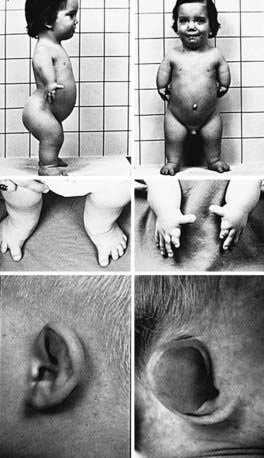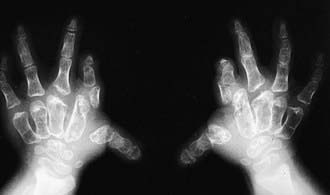Chapter 688 Disorders Involving Ion Transporters
Diastrophic Dysplasia
Diastrophic dysplasia (OMIM 22600) is a well-characterized disorder recognized at birth by the presence of very short extremities, clubfoot, and short hands, with proximal displacement of the thumb producing a hitchhiker appearance (Fig. 688-1). The hands are usually deviated in an ulnar direction. Bony fusion of the metacarpophalangeal joints (symphalangism) is common, as is restricted movement of many joints, including hips, knees, and elbows. The external ears often become inflamed soon after birth. The inflammation resolves spontaneously but leaves the ears fibrotic and contracted (cauliflower ear deformity). Many newborns have a cleft palate.
Radiographs reveal short and broad tubular bones with flared metaphyses and flat, irregular epiphyses (Fig. 688-2).
Hall BD. Diastrophic dysplasia: Extreme variability within a sibship. Am J Med Genet. 1996;63:28-33.
Makitie O, Kaitila I. Growth in diastrophic dysplasia. J Pediatr. 1997;130:641-646.
Newbury-Ecob R. Atelosteogenesis type 2. J Med Genet. 1998;35:49-53.
Rossi A, Superti-Furga A. Mutations in the diastrophic dysplasia sulfate transporter (DTDST) gene (SLC26A2): 22 novel mutations, mutation review, associated skeletal phenotypes, and diagnostic relevance. Hum Mutat. 2001;17:159-171.
Superti-Furga A. Skeletal dysplasias related to defects in sulfate metabolism. In: Royce PM, Steinmann B, editors. Connective tissue and its heritable disorders. New York: Wiley-Liss; 2002:939-960.








